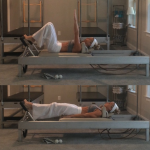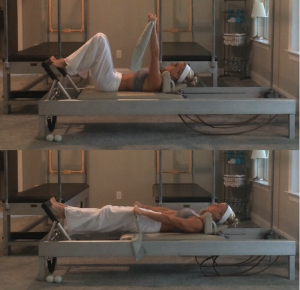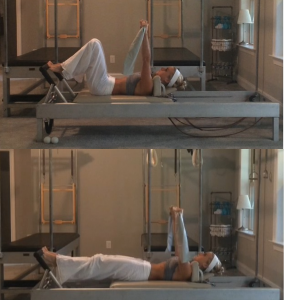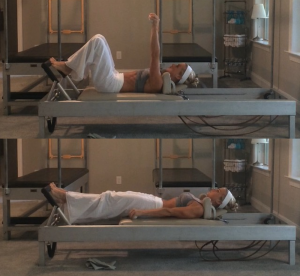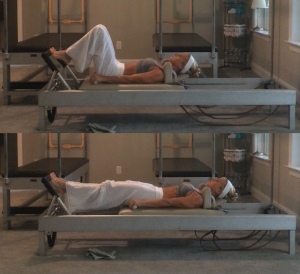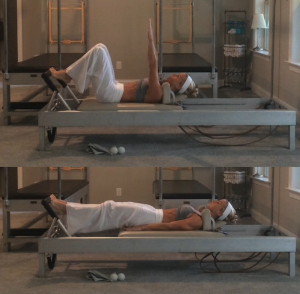What do I mean by props?
Examples:
Balls
Weights
Resistant Bands
Yoga Block
My question is…
What is the real purpose of a prop?
Were props designed to make a movement more challenging or complex? Or, were they supposed to add variety to a Pilates session? Or maybe they are designed to help a client connect with a movement?
Most Pilates’ instructors will say props are used to make a movement more challenging/complex or to add variety, but I think it would be good to consider the “why” on a deeper level. Why did Joseph Pilates invent the Pilates apparatus? Why did he add small props to the program? Pilates was a genius—he observed and studied the body and developed an understanding of the body’s need. He used this knowledge to evaluate specific needs in his clients and developed a tool (prop/apparatus, etc.) to address this need in order that maximum benefits are achieved when performing the Pilates Method.
I advocate that we as instructors might reevaluate the use of props (tools). Today, group studios and individual instructors are using props to make clients feel as though they are being challenged by more advanced work. Joseph Pilates used props as a tool to assist a client having difficulty with a move. The true work of Pilates is powerful. There is no need to add props to make a session/class more advanced (balls, bosu, weights, etc.). If a client is having trouble executing a move, props are appropriate, but work towards mastery of the move without the prop. There are certainly plenty of challenging movements in the Pilates Method that can make the work advanced for clients. Now I am not saying to teach a group full of individuals the Snake and Twist, just proposing a rethink about the use of props (tools).
On the other hand, maybe your clients have become dependent of props and feel less challenged when they are not part of a session. If this is the case, maybe it’s time to reevaluate and go back to the basics.
Our lives are already over stimulated by computers, tablets, phones, etc. The last thing we need to teach our clients is that additional stimulation (props during a session) is a good thing. A Pilates session should be a time to step away from the over stimulated world and reconnect with the body; mentally and physically. Let’s challenge ourselves and our clients to be okay with doing footwork with their hands extended to the side on the carriage and focus on breath and movement. Let me step back and explain. Instead of adding dumbbells to their hands (which I see often these days), teach the client that the movement is ultimately done with the arms extended long to one’s side. Now I understand this is a challenge–especially since most people are attached to a device all day. Address this challenge by having the client hold a lacrosse or tennis ball in their hands while their arms are extended long by their side. Train the client to understand the stillness of the arms is the ultimate goal. As they learn to engage in this concept, remove the balls and observe their connection of mind and body. Does the concept I am trying to make sense? Rather than add the element of dumbbells and creating a distraction from the true work, use a prop as a tool.
As Pilates teachers we are creating patterns, habits, life changes, and an example to our clients. So before adding a prop to a movement to make it more difficult, it might be better to teach the same movement with focus on the true purpose of that movement—the ability to connect with the six principles of Pilates…Breath, Control, Precision, Flow, Centering, and Concentration.
Let me provide and example to illustrate what I mean.
FOOTWORK OBJECTIVES
Full Body Integration
Centering the Body
Warming the body up
Alignment from he feet to the top of the head
MOST COMMON MISTAKES
Focus is all on the legs
Wandering gaze
Fidgeting
Full Body focus is lost
*With Footwork, I recommend focusing on the arms involvement & placement.
-The arms are part of the body and since this movement, like all movements in The Pilates Method, is full body, the arms should be active.
Over the years, I have observed and concluded that adding props to footwork should only be used as a tool to teach proper placement and engagement of the arms and not to increase the difficulty of the movement.
I understand that this detail is often over looked, but I believe addressing this fine-tuning detail is essential to properly prepping the body for the remainder of the session.
As instructors it is our duty to bring awareness, focus, alignment, and concentration to each session. Our ultimate goal should be for our clients to perform deliberate precise movements that connect the mind and body as one.
THE END GOAL OF THE ARMS IN FOOTWORK
Placed alongside the body on the carriage, reaching long, pressing down into the carriage engaging the back body & arm muscles.
Avoiding fidgeting
Creating full body integration
PROGRESSION EXAMPLE with PROPS
*Props needed for this example: flex band & 2 lacrosse balls or tennis balls
Step 1
Flex band in hands shoulder width apart- pulling in slight opposition
Arms move with the movement of the legs
Step 2
Band in hands extended over chest
Arms stay constant as the legs move
*NOTE: In step one & two, the band creates a closed kinetic chain that allows the arms to stay in alignment with the shoulders and prevents body movement during the exercise.
Step 3
Lacrosse balls placed in the hands
Arms move with the movement of the legs
Step 4
Lacrosse balls remain in the hands
Arms extended long by ones side
*NOTE: Removing the flex band creates an opportunity for the arms to fidget. But, the tactile feedback provided by the balls allows the client to remain fully engaged and connected with the arms.
Step 5
No prop in the hands
Arms move with the movement of the legs
Step 6
No prop in the hands
Arms extended long by ones side & engaged (fully connected)
*NOTE: Removing the lacrosse ball creates a lot of room for distraction to occur. Adding step 5 reminds the client to stay connected with the arms without the prop so when step 6 arrives the arms know their purpose.
 Laura has a quick smile, tons of energy and a real passion for life. Her passion for Pilates is infectious and has touched the lives of her clients over the last twelve years. Laura received her Pilates certification from the Pilates Certification Center in 2003 and became a PMA-CPT in 2008. Her enthusiasm for life and knowledge has led her to completion of eleven Pilates specialty courses and, most recently, completion of Lolita San Miguel Pilates Master Mentor Program. As a result, Laura is now recognized as a Second Generation Pilates Instructor and Lolita Disciple Educator. In 2008, Laura also completed her Gyrotonic certification and is recognized as a certified Gyrotonic Level 1 instructor. A giver and not a taker, Laura has chosen to share her love of Pilates by developing and teaching four Pilates Fine Tuning PMA-CEC Workshops—Reformer, Cadillac, Barrel/Spine Corrector and Wunda Chair and PMA-CEC Workshop Pilates for the Athlete. Also, she has developed and teaches a PMA continuing education course addressing Pilates & ADHD after recognizing the role Pilates can play in the treatment of ADHD symptoms. In 2015, Laura was a presenter at the Pilates Heritage Congress in Germany and a contributor to Pilates Bridge. Laura has been featured in Pilates Style Magazine and graced the July/August 2015 cover. Laura was owner of Centered Align Your Life in North Carolina before moving to San Diego in 2009. She taught Pilates in San Diego and Los Angeles for five years and returned to North Carolina in 2015 and opened LaurabPilates studio in two Raleigh locations. In 2013, Laura launched her website, laurabpilates.com, for the purpose of sharing her passion of The Pilates Method with others. Even though she currently teaches in North Carolina, Laura remains committed to the clients she has taught and the instructors she has certified in all parts of the country. You can always count on Laura to remain genuine, loyal, trustworthy and passionate in any situation.
Laura has a quick smile, tons of energy and a real passion for life. Her passion for Pilates is infectious and has touched the lives of her clients over the last twelve years. Laura received her Pilates certification from the Pilates Certification Center in 2003 and became a PMA-CPT in 2008. Her enthusiasm for life and knowledge has led her to completion of eleven Pilates specialty courses and, most recently, completion of Lolita San Miguel Pilates Master Mentor Program. As a result, Laura is now recognized as a Second Generation Pilates Instructor and Lolita Disciple Educator. In 2008, Laura also completed her Gyrotonic certification and is recognized as a certified Gyrotonic Level 1 instructor. A giver and not a taker, Laura has chosen to share her love of Pilates by developing and teaching four Pilates Fine Tuning PMA-CEC Workshops—Reformer, Cadillac, Barrel/Spine Corrector and Wunda Chair and PMA-CEC Workshop Pilates for the Athlete. Also, she has developed and teaches a PMA continuing education course addressing Pilates & ADHD after recognizing the role Pilates can play in the treatment of ADHD symptoms. In 2015, Laura was a presenter at the Pilates Heritage Congress in Germany and a contributor to Pilates Bridge. Laura has been featured in Pilates Style Magazine and graced the July/August 2015 cover. Laura was owner of Centered Align Your Life in North Carolina before moving to San Diego in 2009. She taught Pilates in San Diego and Los Angeles for five years and returned to North Carolina in 2015 and opened LaurabPilates studio in two Raleigh locations. In 2013, Laura launched her website, laurabpilates.com, for the purpose of sharing her passion of The Pilates Method with others. Even though she currently teaches in North Carolina, Laura remains committed to the clients she has taught and the instructors she has certified in all parts of the country. You can always count on Laura to remain genuine, loyal, trustworthy and passionate in any situation.

